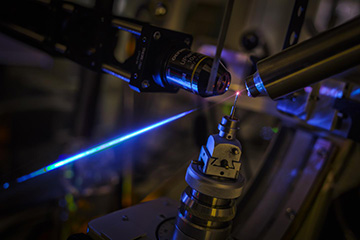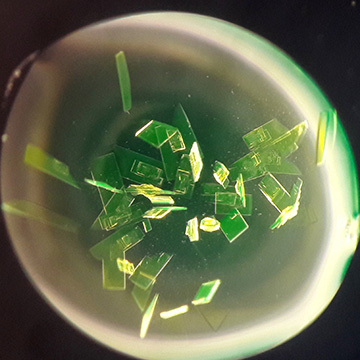
A crystal of a red fluorescent protein placed in a combined instrument consisting of a fluorescence microscope and an X-ray diffractometer. The crystal glows red when illuminated by a blue laser beam. [Image: Petr Pachl / IOCB Prague]
Fluorescent proteins have become a mainstay in biological research as a glowing marker that allow scientists to visualize structural organization and dynamic processes in living cells and organisms. One property of fluorescent proteins that has not been explored in depth is the directionality of their optical properties.
Now, researchers at the Czech Academy of Sciences, Czech Republic, have determined the directionality of light absorption and emission in several commonly used fluorescent proteins (PNAS, doi: 10.1073/pnas.2017379117). Their results, which verified that fluorescent protein molecules behave much like tiny antennas that only absorb light from certain directions, pave the way for novel applications in biological lasers and bioelectronics.
Appreciating directionality
Josef Lazar and his colleagues were initially motivated by a desire to observe electrical signals in neurons of the brain with optical microscopy. At some point, he wondered if they might be able to exploit the fact that optical properties of fluorescent proteins are anisotropic, meaning that the molecules only absorb or emit light from certain directions.
This line of thinking led to the 2011 development of two-photon polarization microscopy, an imaging technique that can observe changes in the conformation of protein molecules labeled by fluorescent proteins. Because it works within living cells and organisms, the method has yielded valuable insights into things like molecular mechanisms of yeast cell division, membrane protein signaling and nuclear pore organization.
“Knowing the directions along which molecules of fluorescent proteins absorb and emit light would extend the abilities of the technique and allow us to learn more about the molecular processes observed by polarization microscopy,” said Lazar. “I also simply thought that directionality is an underappreciated fundamental property of fluorescent protein molecules, and that it deserves more attention.”
Pronounced anisotropy

Crystals of the fluorescent protein mTurquoise2 as seen in an optical microscope. [Image: Josef Lazar / IOCB Prague]
For fluorescent molecules, the directionality of light absorption and emission is characterized by excitation and emission transition dipole moments (TDMs). The researchers used a customized laser-scanning confocal microscope to measure the optical properties of four kinds of fluorescent protein crystals: mTurquoise2, eGFP, mCherry and mEos4b.
To determine the orientation of excitation TDMs, the researchers imaged absorption of the illuminating laser light as a function of the laser light polarization. For emission TDMs, they measured the polarization of emitted fluorescence. Lazar and his colleagues found pronounced anisotropy in all investigated crystals. They determined the directions of these “molecular antennas” with respect to the complex 3D shapes of the proteins.
“We will be using this information to learn about changes in the structure of protein molecules as they participate in various molecular processes taking place in living cells,” said Lazar. “For example, my lab is now applying our knowledge towards improving our understanding of cell-signaling processes triggered by insulin, with the ultimate goal of finding a pharmaceutical drug for treating diabetes that could be used orally.”
In general, the TDM orientations are close to parallel to the long axis of the molecule, as expected. However, having this type of quantitative information on hand will improve investigations that employ not only polarization microscopy, but also fluorescence resonance energy transfer (FRET) measurements. The results also have potential applications in emerging areas such as super-resolution microscopy, biological lasers and bioelectronics.
